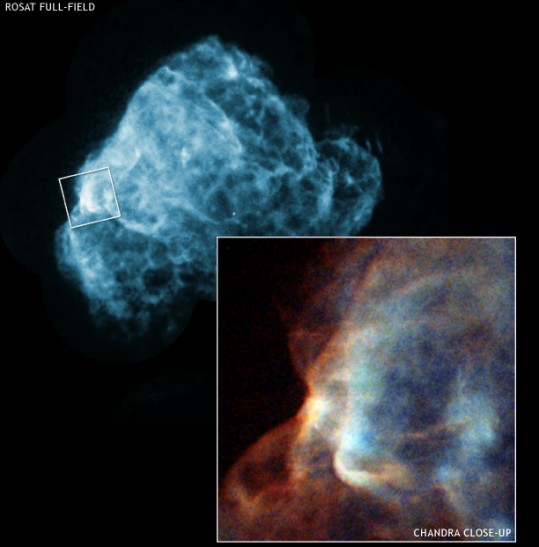Explanation: A massive star ends life as a supernova, blasting its outer layers back to interstellar space. The spectacular death explosion is initiated by the collapse of what has become an impossibly dense stellar core. Pictured is the expanding supernova remnant Puppis A - one of the brightest sources in the x-ray sky. Now seen to be about 10 light-years in diameter, light from the initial stellar explosion first reached Earth a few thousand years ago. Recorded by the Chandra Observatory's x-ray cameras, the inset view shows striking details of the strong shock wave disrupting an interstellar cloud as the shock sweeps through preexisting material. The larger field ROSAT image also captures a of pinpoint source of x-rays near the remnant's center. The source is a young neutron star, the remnant of the collapsed stellar core kicked out by the explosion and moving away at about 1,000 kilometers per second.
1999 2000 2001 2002 2003 2004 2005 2006 2007 2008 2009 2010 2011 2012 2013 2014 2015 2016 2017 2018 2019 2020 2021 2022 2023 2024 2025 |
Yanvar' Fevral' Mart Aprel' Mai Iyun' Iyul' Avgust Sentyabr' Oktyabr' Noyabr' Dekabr' |
NASA Web Site Statements, Warnings, and Disclaimers
NASA Official: Jay Norris. Specific rights apply.
A service of: LHEA at NASA / GSFC
& Michigan Tech. U.
|
Publikacii s klyuchevymi slovami:
supernova - supernova remnant - shock wave - Sverhnovye - ostatok Sverhnovoi - udarnye volny
Publikacii so slovami: supernova - supernova remnant - shock wave - Sverhnovye - ostatok Sverhnovoi - udarnye volny | |
Sm. takzhe:
Vse publikacii na tu zhe temu >> | |
